
The cache is not at the posted coordinates, but it is a good
place to park.
San
Francisco: The first time we visited the City, we lost out
hearts. The city is beautiful. Our first impressions were there's a
lot to see, loads of walking to do and many, many hills. This cache
is located in a San Francisco like location, a long walk and a big
hill. Thanks to peanutbutterbreadandjam for the beautifully
decorated ammo can for this cache. And thanks to wiki for some of
the information about our favorite attractions in San
Francisco.
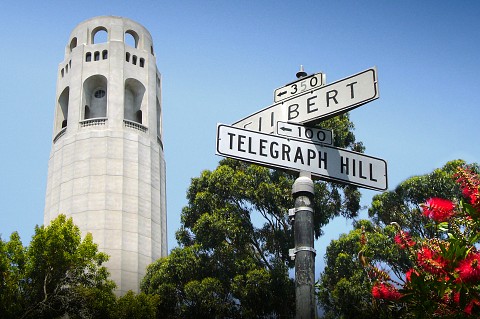 Coit
Tower is a 210-foot (64 m) tower located in the Telegraph
Hill neighborhood of San Francisco, California. The tower, located
in the city's Pioneer Park, was built in 1933 at the bequest of
Lillie Hitchcock Coit to beautify the city of San Francisco; Coit
bequeathed one-third of her estate to the city "to be expended in
an appropriate manner for the purpose of adding to the beauty of
the city which I have always loved."
Coit
Tower is a 210-foot (64 m) tower located in the Telegraph
Hill neighborhood of San Francisco, California. The tower, located
in the city's Pioneer Park, was built in 1933 at the bequest of
Lillie Hitchcock Coit to beautify the city of San Francisco; Coit
bequeathed one-third of her estate to the city "to be expended in
an appropriate manner for the purpose of adding to the beauty of
the city which I have always loved."
The art deco tower, made of unpainted reinforced concrete, was
designed by architects Arthur Brown, Jr. and Henry Howard, with
murals by 26 different artists and numerous assistants.
 Peir 39 is
a shopping center and popular tourist attraction built on a pier in
San Francisco, California. At Pier 39, there are shops,
restaurants, a video arcade, street performances, an interpretive
center for the Marine Mammal Center, the Aquarium of the Bay,
virtual 3D rides, and views of California sea lions hauled out on
docks on Pier 39's marina. The marina is also home to the floating
Forbes Island restaurant. A two-story carousel is one of the pier's
more dominant features, although it is not directly visible from
the street and sits towards the end of the pier. The
family-oriented entertainment and presence of marine mammals make
this a popular tourist location for families with kids.
Peir 39 is
a shopping center and popular tourist attraction built on a pier in
San Francisco, California. At Pier 39, there are shops,
restaurants, a video arcade, street performances, an interpretive
center for the Marine Mammal Center, the Aquarium of the Bay,
virtual 3D rides, and views of California sea lions hauled out on
docks on Pier 39's marina. The marina is also home to the floating
Forbes Island restaurant. A two-story carousel is one of the pier's
more dominant features, although it is not directly visible from
the street and sits towards the end of the pier. The
family-oriented entertainment and presence of marine mammals make
this a popular tourist location for families with kids.

 Victorian
Homes: About 48,000 houses in the Victorian and Edwardian
styles were built in San Francisco between 1849 and 1915 (with the
change from Victorian to Edwardian occurring on the death of Queen
Victoria in 1901), and many were painted in bright colors. As one
newspaper critic noted in 1885, "...red, yellow, chocolate, orange,
everything that is loud is in fashion...if the upper stories are
not of red or blue... they are painted up into uncouth panels of
yellow and brown..." While many of the mansions of Nob Hill were
destroyed by the 1906 San Francisco Earthquake, thousands of the
mass-produced, more modest houses survived in the western and
southern neighborhoods of the city.
Victorian
Homes: About 48,000 houses in the Victorian and Edwardian
styles were built in San Francisco between 1849 and 1915 (with the
change from Victorian to Edwardian occurring on the death of Queen
Victoria in 1901), and many were painted in bright colors. As one
newspaper critic noted in 1885, "...red, yellow, chocolate, orange,
everything that is loud is in fashion...if the upper stories are
not of red or blue... they are painted up into uncouth panels of
yellow and brown..." While many of the mansions of Nob Hill were
destroyed by the 1906 San Francisco Earthquake, thousands of the
mass-produced, more modest houses survived in the western and
southern neighborhoods of the city.
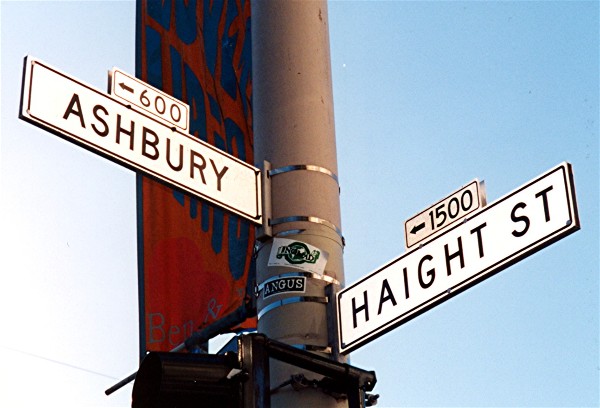 The Haight -
Ashbury district generally encompasses the neighborhood
surrounding Haight Street, bounded by Stanyan Street and Golden
Gate Park on the west, Oak Street and the Golden Gate Park
Panhandle on the north, Baker Street and Buena Vista Park to the
east and Frederick Street and Ashbury Heights and Cole Valley
neighborhoods to the south.
The Haight -
Ashbury district generally encompasses the neighborhood
surrounding Haight Street, bounded by Stanyan Street and Golden
Gate Park on the west, Oak Street and the Golden Gate Park
Panhandle on the north, Baker Street and Buena Vista Park to the
east and Frederick Street and Ashbury Heights and Cole Valley
neighborhoods to the south.
The street names themselves commemorate two early San Francisco
leaders: Pioneer and exchange banker Henry Haight and Munroe
Ashbury, a member of the San Francisco Board of Supervisors from
1864 to 1870. Both Haight and his nephew as well as Ashbury had a
hand in the planning of the neighborhood, and, more importantly,
nearby Golden Gate Park at its inception. The name "Upper Haight",
used by locals, is in contrast to the Haight-Fillmore or Lower
Haight district; the latter being lower in elevation and part of
what was previously the principal African-American and Japanese
neighborhoods in San Francisco's early years.
The Haight-Ashbury district is noted for its role as a center of
the 1960s hippie movement, a post-runner and closely associated
offshoot of the Beat generation or beat movement, members of which
swarmed San Francisco's "in" North Beach neighborhood two to eight
years before the "Summer of Love" in 1967. Many who could not find
space to live in San Francisco's northside found it in the quaint,
relatively cheap and underpopulated Haight-Ashbury. The '60s era
and modern American counterculture have been synonymous with San
Francisco and the Haight-Ashbury neighborhood ever since.
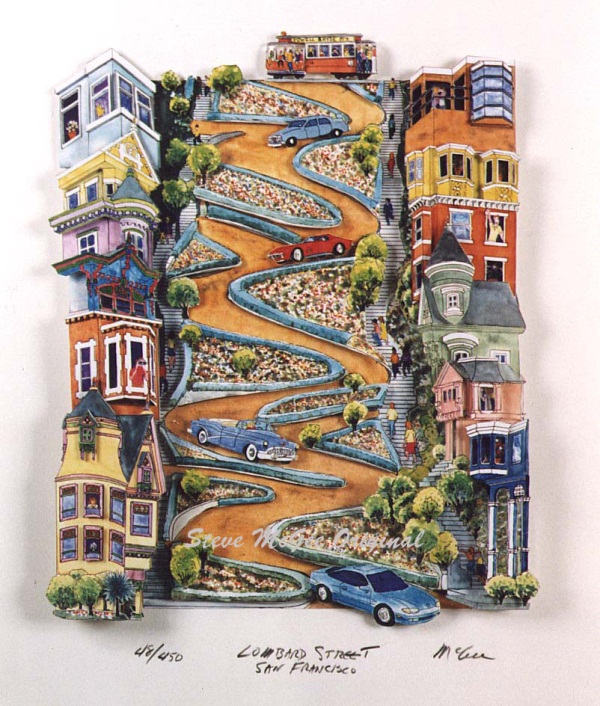 Lombard
Street begins at Presidio Boulevard inside The Presidio and
runs east through the Cow Hollow neighborhood. For 12 blocks
between Broderick Street and Van Ness Avenue, it is a principal
arterial road that is co-signed as U.S. Route 101. Lombard Street
then continues through the Russian Hill and Telegraph Hill
neighborhoods, breaks off at a point becoming Telegraph Hill
Boulevard. That leads to Pioneer Park and Coit Tower. Lombard
Street starts again at Winthrop Street and finally terminates at
The Embarcadero as a collector road.
Lombard
Street begins at Presidio Boulevard inside The Presidio and
runs east through the Cow Hollow neighborhood. For 12 blocks
between Broderick Street and Van Ness Avenue, it is a principal
arterial road that is co-signed as U.S. Route 101. Lombard Street
then continues through the Russian Hill and Telegraph Hill
neighborhoods, breaks off at a point becoming Telegraph Hill
Boulevard. That leads to Pioneer Park and Coit Tower. Lombard
Street starts again at Winthrop Street and finally terminates at
The Embarcadero as a collector road.
Lombard Street is best known for the one-way section on Russian
Hill between Hyde and Leavenworth Streets, in which the roadway has
eight sharp turns (or switchbacks) that have earned the street the
distinction of being the crookedest street in the world. The
switchback's design, first suggested by property owner Carl Henry
and instituted in 1922, was born out of necessity in order to
reduce the hill's natural 27% grade, which was too steep for most
vehicles to climb. It is also a serious hazard to pedestrians, who
are accustomed to a more reasonable sixteen-degree incline. The
crooked section of the street, which is about 1/4 mile (400 m)
long, is reserved for one-way traffic traveling east (downhill) and
is paved with red bricks. The speed limit in this section is a mere
5 mph (8 km/h).
In 1999, a Crooked Street Task Force was created to try to solve
traffic problems in the neighborhoods around the winding section of
Lombard Street. In 2001, the Task Force decided that it would not
be legal to permanently close the block to vehicular traffic.
Instead, the Task Force decided to institute a summer parking ban
in the area, to bar eastbound traffic on major holidays, and to
increase fines for parking in the area. The Task Force also
proposed the idea of using minibuses to ferry sightseers to the
famous block, although residents debated the efficiency of such a
solution, since one of the attractions of touring the area is
driving along the twisting section of the street.
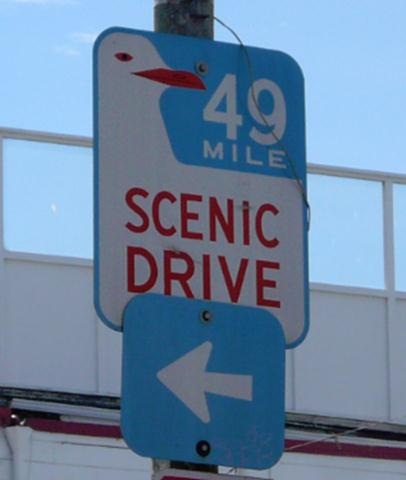 The
49-Mile Scenic Drive Francisco highlights many of the
city's major attractions and historic structures.
The
49-Mile Scenic Drive Francisco highlights many of the
city's major attractions and historic structures.
Opened on September 14, 1938 as a promotion for the 1939 Golden
Gate International Exposition, it features views of the
then-newly-built Golden Gate Bridge (opened May 1937) and the Bay
Bridge (opened November 1936). Then it terminated at the
fairgrounds on Treasure Island.
The blue and white seagull "49-Mile Scenic Drive" sign was designed
by a local artist named Rex May. May's design won the 1955
competition held by San Francisco's Downtown Association to create
a new sign for the route. Prior to 1955 the city used blue and gold
triangular signs. Some sources erroneously cite the origin date of
the newer sign as 1938, which is actually the origin of the
49-Mile-Scenic Drive itself, but not the sign.

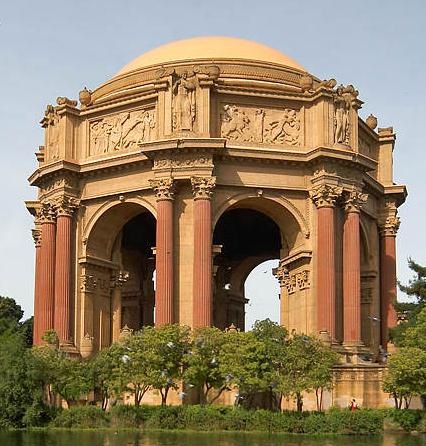 The Palace of
Fine Arts in the Marina District of San Francisco,
California, is a monumental structure originally constructed for
the 1915 Panama-Pacific Exposition in order to exhibit works of art
presented there. One of only a few surviving structures from the
Exposition, it is the only one still situated on its original site.
It was rebuilt in 1965, and renovation of the lagoon, walkways, and
a seismic retrofit were completed in early 2009.
The Palace of
Fine Arts in the Marina District of San Francisco,
California, is a monumental structure originally constructed for
the 1915 Panama-Pacific Exposition in order to exhibit works of art
presented there. One of only a few surviving structures from the
Exposition, it is the only one still situated on its original site.
It was rebuilt in 1965, and renovation of the lagoon, walkways, and
a seismic retrofit were completed in early 2009.
The Palace of Fine Arts was designed by Bernard Maybeck, who took
his inspiration from Roman and Greek architecture in designing what
was essentially a fictional ruin from another time.
Originally intended to only stand for the duration of the
Exhibition, the colonnade and rotunda were not built of durable
materials, and thus framed in wood and then covered with staff, a
mixture of plaster and burlap-type fiber. As a result of the
construction and vandalism, by the 1950's the simulated ruin was in
fact a crumbling ruin.
 The
Giants are a Major League Baseball (MLB) team based in San
Francisco, California, playing in the National League West
Division. They are the current World Series champions, having
defeated the Texas Rangers in the 2010 World Series by four games
to one. As one of the oldest baseball teams,they have won the most
games of any team in the history of American baseball, and any
North American professional sports team. They have won 21 National
League pennants and appeared in 18 World Series competitions,
winning six – both tied with rival Los Angeles Dodgers for
most in the league. The Giants have been invited to the World
Series an NL record 19 times, but boycotted the event in
1904.
The
Giants are a Major League Baseball (MLB) team based in San
Francisco, California, playing in the National League West
Division. They are the current World Series champions, having
defeated the Texas Rangers in the 2010 World Series by four games
to one. As one of the oldest baseball teams,they have won the most
games of any team in the history of American baseball, and any
North American professional sports team. They have won 21 National
League pennants and appeared in 18 World Series competitions,
winning six – both tied with rival Los Angeles Dodgers for
most in the league. The Giants have been invited to the World
Series an NL record 19 times, but boycotted the event in
1904.
The Giants played at the Polo Grounds in Manhattan, New York, until
the close of the 1957 season, after which they moved west to
California to become the San Francisco Giants. As the New York
Giants, they won 14 pennants and 5 World Championships, from the
era of John McGraw and Christy Mathewson to that of Bobby Thomson
and Willie Mays. The Giants have won four pennants and the 2010
World Series since arriving in San Francisco.
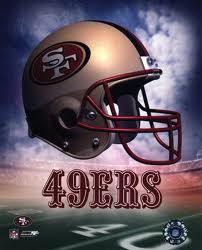 The
49ers are a professional American football team based in
the San Francisco Bay Area. They are currently members of the
Western Division of the National Football Conference (NFC) in the
National Football League (NFL). The team plays its home games in
San Francisco, California, while the club's headquarters and
practice facility are located in nearby Santa Clara.
The
49ers are a professional American football team based in
the San Francisco Bay Area. They are currently members of the
Western Division of the National Football Conference (NFC) in the
National Football League (NFL). The team plays its home games in
San Francisco, California, while the club's headquarters and
practice facility are located in nearby Santa Clara.
The 49ers began play in 1946 as a charter member of the All-America
Football Conference (AAFC) and joined the NFL in 1950 after the
AAFC merged into the older league. The team was the first NFL
franchise to win five Super Bowls. San Francisco is second only to
the Pittsburgh Steelers in Super Bowl wins (6) and tied with the
Dallas Cowboys with 5 each. Their five league titles (which include
the pre-NFL and pre-Super Bowl periods) place them in a four-way
tie for fifth behind the Green Bay Packers (12), the Chicago Bears
(9), the New York Giants (7), and the Steelers (6). The 49ers are
also the only team to win more than one Super Bowl without losing
any.
The name "49ers" comes from the name given to the gold prospectors
who arrived in Northern California around 1849 during the
California Gold Rush.
The team is the oldest major professional sports team in
California, as well as the first. Major League Baseball would not
come for a few more years when the Brooklyn Dodgers and New York
Giants would move to Los Angeles and San Francisco, respectively.
The Philadelphia Warriors and Minneapolis Lakers would move to
California in the sixties, and the Oakland Seals and Los Angeles
Kings would become the first NHL teams in the state in 1967.

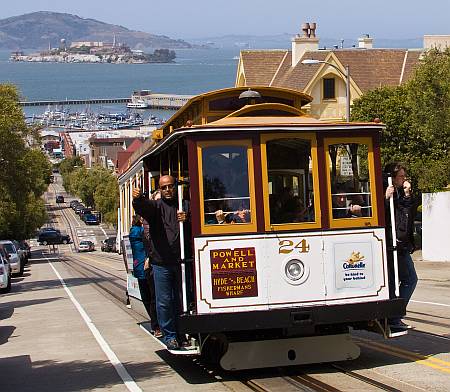 Transportation:
Of all the cities in the world, only San Francisco offers the
opportunity to see such a variety of stunning vistas, historic
sights, diverse neighborhoods and popular attractions from two
different types of vintage rail transit vehicles.
Transportation:
Of all the cities in the world, only San Francisco offers the
opportunity to see such a variety of stunning vistas, historic
sights, diverse neighborhoods and popular attractions from two
different types of vintage rail transit vehicles.
San Francisco’s historic streetcars
(sometimes called trolleys or trams) and the world-famous cable
cars form a “steel triangle” of rails that bring riders
to such destinations as Fisherman’s Wharf, Union Square, the
Castro district, Chinatown, Nob Hill, Jackson Square, North Beach,
Telegraph Hill, and Coit Tower.
These “museums in motion” are the real deal: not
replicas or rubber-tired imitations, but vintage vehicles that
operate every day as part of San Francisco’s public
transportation system, the Municipal Railway (Muni).
The San Francisco cable car
system is the world's last permanently operational manually
operated cable car system, and is an icon of San Francisco,
California. The cable car system forms part of the intermodal urban
transport network operated by the San Francisco Municipal Railway,
or "Muni" as it is better known. Cable cars operate on two routes
from downtown near Union Square to Fisherman's Wharf, and a third
route along California Street. While the cable cars are used to a
certain extent by commuters, their small service area and premium
fares for single rides make them more of a tourist attraction. They
are among the most significant tourist sites in the city, along
with Alcatraz Island and Fisherman's Wharf.
It is the only transportation system listed on the National
Register of Historic Places.
Both streetcars and cable cars were invented in the 19th century,
both run on steel rails, and both are fun to ride.

